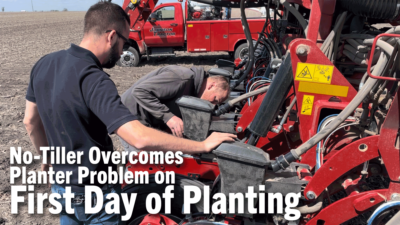By Sjoerd Duiker, Soil Scientist
There are three types of crusts: chemical, biological and physical. Chemical crusts are the result of encrusted salt on soils in arid or semi-arid regions. Biological crusts are primarily formed by algal growth and occur when ponded water stands and retreats on soils with low permeability. Physical crusts are the result of structural degradation of the surface soil and may be classified as structural or depositional.
Physical crusts are most common in Pennsylvania. Structural crusts are formed when surface aggregates disintegrate due to the forces of raindrops of irrigation water. Depositional crusts are formed by transport and deposition of fine particles from eroded surfaces in depositional areas.
Both rainfall characteristics and soil properties influence crust formation. Heavy, intense rain has high kinetic energy, primarily because of large drop size and high rainfall rate. Similarly, there are differences between irrigation systems due to drop size distribution reaching the soil surface.
This spring brought some high intensity rainstorms, which contributed to the threat of soil crusting. Normally, however, highest intensity rainfall is experienced in summer or in hurricane season.
Rainfall characteristics also vary by region, with occurrence of high intensity rainfall increasing from north to southeastern Pennsylvania. As a result, crust formation can be expected to be a greater problem in the southeastern part of the state than in the north.
The most important explanatory factor of differences in crusting, however, is the soil. It seems that most of our soils are susceptible to crusting due to the fact that they have a range of particle sizes in the surface soil. When the soils are weakly aggregated, the impact of drops causes the fines to fill in the pores between the large particles. The result is a very thin layer (only a few millimeters thick) that, upon drying, is cemented into a crust with low permeability and high tensile strength. Water will not, or very slowly, infiltrate. This leads to runoff on soils that are still dry under the crust; gas exchange between air and soil atmosphere will be inhibited; and seedlings have to exert great strength to push through the crust.
There are several ways farmers can address soil crusting. First, protect the soil from the impact of raindrops by keeping it covered. This means no tillage and no removal of crop residue from the row.
Second, the surface soil structure needs to be improved. This can be done by increasing the organic matter content in the very top of the soil, as is achieved by using no-till continuously, and by adding organic matter in the form of manure, compost, cover crops and crop residues.
Stimulating soil biological activity is another way to make soil resist crusting — for example, earthworms deposit casts on the soil surface and these casts exhibit high resistance against disintegration.
If you have a field that suffers from crusting right now, there are a things you can do. The crust needs to be broken up, and the best tool to achieve that is probably the rotary hoe. Another tactic is to plant seeds close together, because they will be able to push through a crust by joint force. This tactic could be applied by planting soybeans with a planter at 30-inch row spacings and narrower spacing in the row, instead of with a drill with 7.5-inch row spacing and wider spacing in the row. Increasing seeding rates may also help for the same reason.
Seeding depth may also be a factor to consider. Deep planting should be avoided in a crust-sensitive soil to allow the seedling to emerge before the crust reforms. It is also advisable to avoid very early planting dates so crusts do not have time to form above the seedlings prior to emergence.






Post a comment
Report Abusive Comment